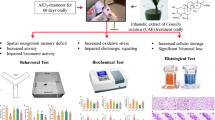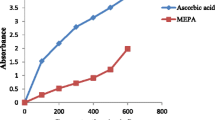Abstract
Alzheimer’s disease affects daily routine due to loss of memory and decline in cognition. In vitro data showed acetylcholine esterase inhibition activity of Malva neglecta but no in vivo evidence is available. The current study aims to investigate the anti-Alzheimer’s activity of Malva neglecta methanolic extract in the AlCl3-induced Alzheimer disease rats’ model. Thirty Wistar rats were divided into six groups and respective doses were given orally for 21 days. Behavioural observations were recorded and biochemical analysis was performed on brain homogenate. Improvement in memory and cognition was noted in treated rats as compared to disease control. A dose-dependent decrease (0.530 ± 0.009 at 200 mg/kg, 0.212 ± 0.007 at 400 mg/kg, 0.173 ± 0.005 at 600 mg/kg) in AChE activity was noted in the treatment groups with reference to disease control value (1.572 ± 0.013). This decrease in AChE activity is linked with an increase in acetylcholine in the brain which plays a key role in retaining memory. Oxidative stress biomarkers; GSH (66.77 ± 0.01 at 600 mg/kg), SOD (26.60 ± 0.10 at 600 mg/kg), CAT (21.46 ± 0.01 at 600 mg/kg) levels were increased with a decrease in MDA (103.33 ±0.49 at 600 mg/kg) level in a dose-dependently manner in the treatment groups as compared to disease control respective values. It is concluded that Malva neglecta could ameliorate Alzheimer’s symptoms possibly by decreasing AChE activity and oxidative stress.
Graphical abstract








Similar content being viewed by others
Data availability
Available upon request.
References
Abbas M, Saeed F, Anjum FM, Afzaal M, Tufail T, Bashir MS, Ishtiaq A, Hussain S, Suleria HAR (2017) Natural polyphenols: An overview. Int J Food Prop 20(8):1689–1699
Arendt T (2009) Synaptic degeneration in Alzheimer’s disease. Acta Neuropathol 118(1):167–179
Aslam M, Sial AA (2014) Neuroprotective effect of ethanol extract of leaves of Malva parviflora against amyloid-β-(Aβ-) mediated Alzheimer’s disease. Int Sch Res Notices 2014:156976. https://doi.org/10.1155/2014/156976
Beuscher L, Beck C (2008) A literature review of spirituality in coping with early-stage Alzheimer's disease. J Clin Nurs 17(5a):88–97
Bitu Pinto N, da Silva Alexandre B, Neves KRT, Silva AH, Leal LKA, Viana GS (2015) Neuroprotective properties of the standardized extract from Camellia sinensis (green tea) and its main bioactive components, epicatechin and epigallocatechin gallate, in the 6-OHDA model of Parkinson’s disease. Evid Based Complement Alternat Med 2015:161092. https://doi.org/10.1155/2015/161092
Brookmeyer R, Johnson E, Ziegler-Graham K, Arrighi HM (2007) Forecasting the global burden of Alzheimer’s disease. Alzheimers Dement 3(3):186–191
Chauhdary Z, Saleem U, Ahmad B, Shah S, Shah MA (2019) Neuroprotective evaluation of Tribulus terrestris L. in aluminum chloride induced Alzheimer’s disease. Pak J Pharm Sci 32(2):805–816
Daglia M, Di Lorenzo A, Nabavi SF, Talas ZS, Nabavi SM (2014) Polyphenols: well beyond the antioxidant capacity: gallic acid and related compounds as neuroprotective agents: you are what you eat! Curr Pharm Biotechnol 15(4):362–372
Dalar A, Türker M, Konczak I (2012) Antioxidant capacity and phenolic constituents of Malva neglecta Wallr. and Plantago lanceolata L. from Eastern Anatolia Region of Turkey. J Herbal Med 2(2):42–51
Deloncle R, Huguet F, Fernandez B, Quellard N, Babin P, Guillard O (2001) Ultrastructural study of rat hippocampus after chronic administration of aluminum L-glutamate: an acceleration of the aging process. Exp Gerontol 36(2):231–244
Elosta A, Ghous T, Ahmed N (2012) Natural products as anti-glycation agents: possible therapeutic potential for diabetic complications. Curr Diabetes Rev 8(2):92–108
Emanuele E et al (2005) Circulating levels of soluble receptor for advanced glycation end products in Alzheimer disease and vascular dementia. Arch Neurol 62(11):1734–1736
Feng Q, Ma Y, Mu S, Wu J, Chen S, OuYang L, Lei W (2014) Specific reactions of different striatal neuron types in morphology induced by quinolinic acid in rats. PLoS One 9(3):e91512
Ferri CP et al (2005) Global prevalence of dementia: a Delphi consensus study. Lancet 366(9503):2112–2117
Haass C, Selkoe DJ (2007) Soluble protein oligomers in neurodegeneration: lessons from the Alzheimer's amyloid β-peptide. Nat Rev Mol Cell Biol 8(2):101–112
Hamedi A, Zengin G, Aktumsek A, Selamoglu Z, Pasdaran A (2020) In vitro and in silico approach to determine neuroprotective properties of iridoid glycosides from aerial parts of Scrophularia amplexicaulis by investigating their cholinesterase inhibition and anti-oxidant activities. Biointerface Res Appl Chem 10(3):5429–5454
Han J, Isoda H (2011) Neuroprotective effects of 3,5-di-o-caffeoylquinic acid in vitro and in vivo. BMC Proc 5(Suppl 8):P20
Han J, Miyamae Y, Shigemori H, Isoda H (2010) Neuroprotective effect of 3, 5-di-O-caffeoylquinic acid on SH-SY5Y cells and senescence-accelerated-prone mice 8 through the up-regulation of phosphoglycerate kinase-1. Neuroscience 169(3):1039–1045
Hira S, Saleem U, Anwar F, Ahmad B (2018) Antioxidants attenuate isolation-and L-DOPA-induced aggression in mice. Front Pharmacol 8:945
Karković Marković A, Torić J, Barbarić M, Jakobušić Brala C (2019) Hydroxytyrosol, tyrosol and derivatives and their potential effects on human health. Molecules 24(10):2001
Keyrouz E, El Feghali PAR, Jaafar M, Nawas T (2017) Malva neglecta: A natural inhibitor of bacterial growth and biofilm formation. J Med Plant Res 11(24):380–386
Khan H, Ullah H, Aschner M, Cheang WS, Akkol EK (2020) Neuroprotective effects of quercetin in Alzheimer’s disease. Biomolecules 10(1):59
Kumar A, Dogra S, Prakash A (2009) Protective effect of curcumin (Curcuma longa), against aluminium toxicity: Possible behavioral and biochemical alterations in rats. Behav Brain Res 205(2):384–390
Mattson MP (2004) Pathways towards and away from Alzheimer's disease. Nature 430(7000):631
Medina S, Collado-González J, Ferreres F, Londoño-Londoño J, Jiménez-Cartagena C, Guy A, Durand T, Galano J-M, Gil-Izquierdo A (2017) Quantification of phytoprostanes–bioactive oxylipins–and phenolic compounds of Passiflora edulis Sims shell using UHPLC-QqQ-MS/MS and LCIT-DAD-MS/MS. Food Chem 229:1–8
Mook-Jung I, Shin JE, Yun SH, Huh K, Koh JY, Park HK, Jew SS, Jung MW (1999) Protective effects of asiaticoside derivatives against beta-amyloid neurotoxicity. J Neurosci Res 58(3):417–425
Müller WE, Eckert A, Kurz C, Eckert GP, Leuner K (2010) Mitochondrial dysfunction: common final pathway in brain aging and Alzheimer’s disease—therapeutic aspects. Mol Neurobiol 41(2–3):159–171
Oh YS (2016) Bioactive compounds and their neuroprotective effects in diabetic complications. Nutrients 8(8):472
Ojha S, Javed H, Azimullah S, Khair SBA, Haque ME (2015) Neuroprotective potential of ferulic acid in the rotenone model of Parkinson’s disease. Drug Des Devel Ther 9:5499
Özüdoğru B, Akaydın G, Erik S, Yesilada E (2011) Inferences from an ethnobotanical field expedition in the selected locations of Sivas and Yozgat provinces (Turkey). J Ethnopharmacol 137(1):85–98
Papetti A, Maietta M, Corana F, Marrubini G, Gazzani G (2017) Polyphenolic profile of green/red spotted Italian Cichorium intybus salads by RP-HPLC-PDA-ESI-MSn. J Food Compos Anal 63:189–197
Petrásek T et al (2018) McGill transgenic rat model of Alzheimer's disease displays cognitive and non-cognitive impairments and altered circadian clock function. Front Aging Neurosci 10:250
Ren Z, Zhang R, Li Y, Li Y, Yang Z, Yang H (2017) Ferulic acid exerts neuroprotective effects against cerebral ischemia/reperfusion-induced injury via antioxidant and anti-apoptotic mechanisms in vitro and in vivo. Int J Mol Med 40(5):1444–1456
Saleem U, Raza Z, Anwar F, Ahmad B, Hira S, Ali T (2019a) Experimental and Computational Studies to Characterize and Evaluate the Therapeutic Effect of Albizia lebbeck (L.) Seeds in Alzheimer’s Disease. Medicina 55(5):184
Saleem U, Raza Z, Anwar F, Chaudary Z, Ahmad B (2019b) Systems pharmacology based approach to investigate the in-vivo therapeutic efficacy of Albizia lebbeck (L.) in experimental model of Parkinson’s disease. BMC Complement Altern Med 19(1):352
Saleem U, Khalid S, Zaib S, Anwar F, Ahmad B, Ullah I, Zeb A, Ayaz M (2020) Phytochemical analysis and wound healing studies on ethnomedicinally important plant Malva neglecta Wallr. J Ethnopharmacol 249:112401
Santos J, Oliveira MBPP, Ibáñez E, Herrero M (2014) Phenolic profile evolution of different ready-to-eat baby-leaf vegetables during storage. J Chromatogr A 1327:118–131
Sawmiller D et al (2016) Diosmin reduces cerebral Aβ levels, tau hyperphosphorylation, neuroinflammation, and cognitive impairment in the 3xTg-AD mice. J Neuroimmunol 299:98–106
Selamoglu-Talas Z, Ozdemir I, Ciftci O, Cakir O (2013) Propolis attenuates oxidative injury in brain and lung of nitric oxide synthase inhibited rats. J Pharm Care 1(2):45–50
Thenmozhi AJ, Raja TRW, Janakiraman U, Manivasagam T (2015) Neuroprotective effect of hesperidin on aluminium chloride induced Alzheimer’s disease in Wistar rats. Neurochem Res 40(4):767–776
Weinreb O, Amit T, Mandel S, Youdim MB (2009) Neuroprotective molecular mechanisms of (−)-epigallocatechin-3-gallate: a reflective outcome of its antioxidant, iron chelating and neuritogenic properties. Genes Nutr 4(4):283–296
Weisz GM, Kammerer DR, Carle R (2009) Identification and quantification of phenolic compounds from sunflower (Helianthus annuus L.) kernels and shells by HPLCDAD/ESI-MSn. Food Chem 115(2):758–765
Winter AN, Brenner MC, Punessen N, Snodgrass M, Byars C, Arora Y, Linseman DA (2017) Comparison of the neuroprotective and anti-inflammatory effects of the anthocyanin metabolites, protocatechuic acid and 4-hydroxybenzoic acid. Oxidative Med Cell Longev 2017:6297080. https://doi.org/10.1155/2017/6297080
Yokel RA (2000) The toxicology of aluminum in the brain: a review. Neurotoxicology 21(5):813–828
Acknowledgements
Authors are thankful to Riphah Institute of Pharmaceutical Sciences for providing laboratory facilities to complete biochemical analysis.
Author information
Authors and Affiliations
Contributions
US conceived and designed research. US, MA and BA drafted the manuscript. RA and ZC performed the experimental work. FA did calculations of the experiment. All authors read and approved the manuscript and all data were generated in-house and that no paper mill was used.
Corresponding author
Ethics declarations
Ethics approval
All applicable international and national guidelines for the care and use of animals were followed.
Consent to participate
All authors agree to participate.
Consent for publication
All authors agree to publish.
Conflict of interest
The authors declare that they have no conflict of interest.
Additional information
Publisher’s note
Springer Nature remains neutral with regard to jurisdictional claims in published maps and institutional affiliations.
Rights and permissions
About this article
Cite this article
Saleem, U., Akhtar, R., Anwar, F. et al. Neuroprotective potential of Malva neglecta is mediated via down-regulation of cholinesterase and modulation of oxidative stress markers. Metab Brain Dis 36, 889–900 (2021). https://doi.org/10.1007/s11011-021-00683-x
Received:
Accepted:
Published:
Issue Date:
DOI: https://doi.org/10.1007/s11011-021-00683-x




